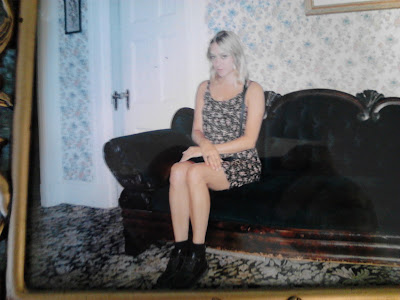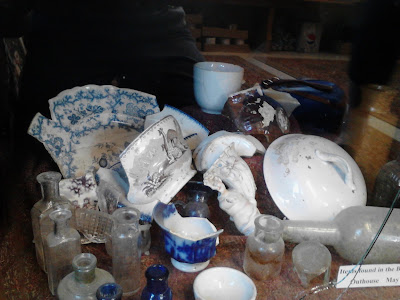If
a woman was accused of murdering her father and stepmother, both of whom were
brutalized with a hatchet, and you knew she had been trying to buy poison the day
before, wouldn't you consider that important evidence?
The
judges in the Lizzie Borden case didn't.
 |
| Eli Bence, upright and concerned gentleman druggist, from findagrave.com |
When
Eli Bence, a druggist, tried to testify on the ninth day of the trial that
Lizzie had come in and tried to buy prussic acid from him, the defense attorney
objected. The jury was temporarily taken out, as was Bence.
Prussic
acid, by the way, is hydrogen cyanide. It was used as an ingredient in Zyklon
B.
 |
In the 1800s poison bottles were sometimes in the shape of skulls,
so even if blindly clutching a bottle in your candlelit pantry,
you would know it was dangerous. From wired.com |
In
a conference at the bench, prosecution attorney William H. Moody (who would
later serve as U.S. Attorney General) told the judges what Bence was preparing
to say: Lizzie had tried to buy prussic acid, saying it was for cleaning her
sealskin cape, and he had refused to sell it to her since she didn't have a
prescription. Lizzie had lightly argued, saying she had bought it there several
times before.
Lizzie's
attorney George Robinson (former governor of Massachusetts) objected, saying
since there had been no sale, the testimony didn't matter. Hosea Knowlton, the
other prosecuting attorney, stated that he had evidence she had tried to buy
prussic acid in another place, also unsuccessfully.
Robinson countered that
since no poison had been found in the stomach of Andrew and Abby Borden,
"There is shown no connection, as assailing the lives of these two
persons....it is an attempt to charge her with an act causing death by a wholly
different means, for which, of course, she is not now on trial."
Robinson
went on to say that since the prussic acid attempt was on Aug. 3 (1892), and
the murders were on the 4th, "the nearness of time may be considered out
of this consideration; it is not sufficiently near, if it were pertinent."
 |
| Lizzie Borden, sometime after her acquittal. |
Call
me crazy, but the day before is pretty darn near. I guess, however, if the only
way you can even begin to wrap your mind around a woman committing such a crime
(please see my previous post about Lizzie not facing a jury of her
peers) is if you consider it a crime of passion, then the previous day doesn't
work. Because that reconstitutes the crime as one of premediation
(although...if Abby was murdered at least an hour before Andrew— and she was—
that also takes "crime of passion" off the table).
Robinson
continued on to say that even if Lizzie
did try to buy the prussic acid, it was "an article which a person may
legitimately buy." He closed with, "Does it have any tendency at all
to show that this defendant killed these two persons with an ax? That is all we
are inquiring about. I maintain it does not."
Moody
rightfully jumped in to claim premeditation. He raised the issue that the
Bordens were ill days before the murders. He said that the day before the
murders*, Mrs. Borden had gone to the neighbor, Dr. Bowen, "and stated
that she had been poisoned the night before." Not food poisoned: poisoned.
*Records
suggest her visit to Dr. Bowen was in fact on Aug. 2 rather than the 3rd.
 |
A late 1800s drugstore (in New Zealand). Not exactly Fall River, but we can still picture
Lizzie Borden stepping up to the counter. |
Moody
discusses the concept of relevance, referring to "Mr. Wharton's treatise
upon Evidence." (Another blog post for another day: the
Shakespeare-spouting prosecution as too erudite and professorial for the farmer
jury who resented city folk. Victoria Lincoln's book A Private Disgrace
contains a great rumination on this).
He
then threw down precedents from Massachusetts and other states. One interesting
one was from Pennsylvania, where a man had stated earlier in the day that he
wanted to kill someone before the day was out, and then he was charged for the
homicide of someone killed that day. Moody went on for a long time talking
about other cases. (Another blog post for another day: the sheer boredom
endured by the jury. The transcripts even show the attorneys talking about how
they had to break for the day because no one was listening).
Robinson's
last hurrah: Lizzie herself was sick; why would she poison herself? Moreover,
she hadn't stated she was buying the prussic acid to kill anyone: "My
friend [Moody] said in his admission that there is nothing in this evidence to
show against whom she premeditated the malice." He made a strange
hypothetical comparison, supposing that Lizzie had bought the poison to kill
Bridget Sullivan, the maid.
Moody:
"There is a tendency to show to whom the malice is directed."
Robinson:
"Is that what you said?"
Moody: "That is what I said."
Robinson:
"...where is it? where is the least tendency? Where a scrap, even? Well,
people buy prussic acid to kill animals--it may be the cat...."
 |
| Take your choice: prussic acid or hatchet, shall we say? |
More
legal bickering ensued, then the justices withdrew for consultation. They
thought the evidence was competent, and they would hear preliminary evidence
before deciding whether Bence could testify.
The
next day, preliminary evidence was heard from a pharmacist, furrier and
chemist, all talking about if prussic acid could be used for the purpose stated
by the mysterious shopper in Bence's drugstore (short answer: no, although my
edited version of the trial transcript doesn't contain their testimony).
That
was followed by a half-hour confab between justices and counsel at the bench,
"all speaking in low tones and out of the hearing of the
stenographer" (Pearson 252).
 |
| Eli Bence |
What
was said in that conference? We'll never know (but keep reading, there's a
theory below). The upshot: the poison evidence was excluded, and Bence was not
allowed to testify.
So
here are some of my thoughts.
I
think Lizzie tried some kind of homemade poison first. Everyone sickened, but
no one died. So she tried to buy real poison, asking for prussic acid as a
cleaning agent to disguise its real purpose, but no one would sell it to her.
In frustration, she turned to the hatchet.
My
response to Robinson would've been, yes, the two methods (poison and ax) are
very different, but doesn't it seem like the more "genteel,
woman-acceptable" form of murder would be first selected by Miss Borden?
Circling
back to what was generally accepted to be food poisoning within the Borden
household, a few things are important to note:
- Everyone was sick,
including the maid Bridget Sullivan and Lizzie herself. Lizzie could've
claimed to be sick, going into the basement water closet and making the
right sounds if anyone was listening, but poor Bridget went out into the
yard to vomit. If we accept the idea that Lizzie tried to buy prussic
acid:
a)
she
had to poison Bridget to cover her tracks, or
b)
she
didn't expect Bridget to eat the dish she'd poisoned, or
c)
Bridget
only claimed to vomit, which would mean she was in on the plot.
- They might've really
had food poisoning as a strange coincidence with Lizzie's attempts to buy
poison. Much was made of the sad fact that the family had been eating, in
varying incarnations, the same roast of mutton for a week. Although they
had an icebox with a melting chunk of ice instead to chill the leftover
meat, the first week of August 1892 was unseasonably hot. In fact, I
watched a play about ten years ago in San Francisco, the main thesis of
which was that the heat drove Lizzie to her nefarious deeds. On the
morning of Aug. 4, breakfast included, among the more-expected
johnnycakes, warmed over mutton stew. One could insert a poor-taste joke
that perhaps the elder Bordens did themselves in after that repast.
 |
| Bence's low-key tombstone, from findagrave.com |
I
had long considered Lizzie's attempts to buy poison one of the two most
compelling indications of her guilt, the other being her burning of a dress
shortly after being informed she was a suspect.
Yet
my tour of the Lizzie Borden house, led by incredibly well-informed guide
Colleen Johnson, introduced a bit of explanation I had never heard before. She
said that the conference at the bench was about a secret police sting whereby
police officers' wives would enter drugstores and try to procure poisons
without a prescription. The sting was ongoing, hence the need for secrecy.
Moreover, one officer's wife resembled Lizzie Borden. It was a case of mistaken
identity.
I'd love to have the existence of the sting solidly confirmed. A few
questions arise:
- Do police files still
exist to confirm the planning and implementation of such an operation?
- Was there an upsurge in
arrests for druggists during this period? Perhaps newspaper police
blotters could bear this out.
- Would such a sting, in
operation in August 1892 when Lizzie was reportedly trying to buy poison,
still be either happening a year later during her trial, or still so fresh
it couldn't be released to the public?
In
favor of this theory is the oddity of the judges so readily dismissing Bence as
a witness. It would explain the very lame explanation that was given for
suppressing the evidence. It would also instantly explain away Knowlton's
stated knowledge of other attempts at other drugstores.
Tour
guide Colleen Johnson has been incredibly helpful, answering questions for me
via email after all the millions of questions I asked her in person. She sent
me the following quotation in response to my questions about the sting:
According to an article in the Fall River Evening News, published on August
15th, 1892
..."The poison theory, so far as actual use of the drugs by the victims is
concerned, has been practically given up. The importance now attached to
the alleged effort of Miss Borden to purchase prussic acid is based upon
the theory that she intended to use it herself, should she be suspected of
the crime. This, however, is not very tenable, as Miss Borden had ample
opportunity to do away with herself since these suspicions were made known
to her by other means. The fact that Inspector McCaffrey has several
female agents in Fall River at the time of the murders, also leads many to
believe that the identification of Miss Borden as a person who sought to
buy prussic acid is a case of mistaken identity"
The above quote is taken from a book called Lizzie Didn't Do It, by William
Masterton,
page 176.
Interesting
that there was a thought Lizzie bought poison as a suicide measure if she was
imprisoned (the punishment, had she not been acquitted, was death by hanging,
so possibly preferable?). Then there is that mention of "female
agents," which tends to support the idea of the sting.
This
case has so many twists and turns it is no surprise it is so studied and talked
of today.
In
other news, in honor of October's witchy gloom, my novel The Witch's Trinity
is on ebook sale until Oct. 24 at only $1.99. When medieval German woman Gude
is accused of witchcraft by her own daughter-in-law, she must examine herself
to see if the finger pointing is true.
"In searingly simple prose, Mailman
probes the human psyche, peeling back the layers of the basest human instincts
to expose the dangerous frailties of the human soul." —Booklist
“A
disturbingly effective historical novel.” —Boston Globe
Note:
All trial quotations in this post are from Trial of Lizzie Borden by
Edmund Pearson, 1937 (1989 Notable Trials reprint).
. .
.














































